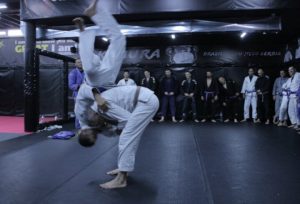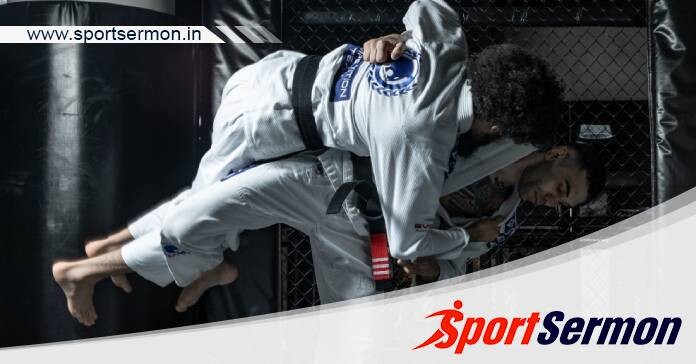BJJ Throws: Throwing the opponent with flawless technique is one of the most dramatic techniques to force the fight to the ground. Judo is known as “the art of hitting someone with the planet,” according to popular culture. It makes for an extremely dangerous grappler who can dominate the opponent both on the ground and in the air when combined with BJJ.
Combat may be brought to the ground in BJJ using a variety of tactics, including throws. In particular, the throws that work best in BJJ will be covered in this essay, along with everything else you need to know about throws.
What Is A Throw?
Throwing techniques in judo are also known as Nage-Waza (throwing techniques), and they include lifting and throwing your opponent to the ground. Since judo places the most emphasis on throws among all grappling martial arts, it has the most skilled throwers. As a result, several of Judo’s techniques are used by other martial arts, such as BJJ, to enhance their standing technique. Leg, hip, shoulder, hand, and sacrifice throws are just a few of the several sorts of assaults that can be classified as throwing.
Leg Throws
Leg throws are moves in which you use your leg to lift your opponent’s leg off the ground while controlling their upper body. This causes them to lose their balance and fall over. These strategies entail raising or hooking motions with your legs to trip the adversary.
Shoulder Throws
You lift your opponent off the ground and hurl them over your shoulder while performing a shoulder throw. In Japanese, it is referred to as Seoi Nage (back throw), while throws that unbalance the opponent by hauling them over your shoulder are referred to as Seoi-Otoshi (backdrop).
Hip Throws
Hip throws are throwing methods where you use your hips as a pivot point and lower them below the opponent’s centre of gravity. In Japanese, hip throws are referred to as Koshi Waza. The O-Goshi, which means whole hip throw, is the hip throw that is most frequently taught to novices.
Sacrifice Throws
These are throwing manoeuvres in which the thrower purposefully places themselves beneath the opponent’s centre of mass or the ground, possibly putting themselves in a less favourable position than they would otherwise be. Intentionally falling increases the throw’s velocity and force. The Ma-Sutemi-Waza (rear sacrifice throw) and the Yoko-Sutemi-Waza (side sacrifice throw) are two varieties of these throws, together known as Sutemi Waza.
You might also be interested in reading this: Who Are The Top 11 BJJ Guard Players?
Six Effective BJJ Throws

Every grappler ought to be able to defeat their opponent. A perfectly executed throw will usually take the opponent by surprise. As a result, you have a little window of opportunity to apply submissions quickly and put an end to the battle before they can even begin to recover. The top six BJJ throws are displayed here.
1) Ouchi Gari
BJJ practitioners frequently choose a wide, dropped posture to begin the bout. This is done because doing it this way makes it simpler to predict guard pulls. When up against such foes, you have the ouchi gari as an alternative. If your opponent grips your collar with their backhand during a bout while standing awkwardly, break their hold right away. Never let the opponent use their favoured grips, as a general rule.
After releasing the hold, establish an angle by switching to a two-on-one grip by wide-stepping with your back leg to the side, grabbing the opponent behind the hip with your lead hand, and controlling their backhand with your far hand. You are now in a T position as a result. Utilise your head to push through as they bring their hand to their hip. To complete the ouchi gari, descend as you contact and use your front leg to hook their leg.
2) Ippon Seoi Nage
When confronting opponents who are taller than you, you can use the Ippon Seoi Nage method. When carried out properly, it will definitely impress your training companions. It may be a surprise assault when you are ready to lose your position.
It will be challenging to advance and attack the opponent’s body if they are able to hold your collar and sleeve on the opposite side. When this occurs, take a step back and bring their hand up and over your body. Make sure you have a firm hold on the side of your arm that controls your collar. Pull the opponent towards you as their hand crosses your torso, catch them as they advance, and complete the throw.
This configuration works because their arm is crossed across their torso and is trapped. Although you should be aware that there is a chance your back might be attacked when completing this throw, try to move as quickly as you can and use multiple settings to make it work.
3) O-Goshi
Gripping the opponent’s sleeve or lapel with your rear hand is the best way to properly set up the o-goshi. To strengthen your position, provide a firm grasp that is frequently higher than your opponent’s hand on their back. If they block your biceps as you attempt to use the high grip, go behind the opponent and grab behind their hips.
From here, you may finish the o-goshi by throwing your hips over. Keep in mind that when you strike from a staggered posture, you may fling your hips across and force your opponent to lean forward, which can throw them off-balance.
4) Koshi Guruma
One of the best throws you can do is the koshi guruma if the opponent is standing. Hold the opponent’s hand just above their left elbow to force it to stay at the peak of the throw. By extending their arm, you may approach closer to them. Place your right hand on the person’s shoulder that is turned in the other direction.
Cross over their body with your right foot and raise their arm with your left hand. As you lean forward to complete the throw, wrap your head with your right hand by reaching behind their neck or towards their opposite shoulder as you move your body. As the opponent may attempt to counter with a body lock from back control, keep in mind to completely commit to the throw.
5) Sumi Gaeshi
According to John Danaher, the two throws that work best for Jiu-Jitsu, especially for novices, are the sumi gaeshi and tomoe nage. During the sumi gaeshi, if your opponent leads with their left leg, occupy the outer position while they move towards the inner position with your right leg. Grab over their shoulder with your right hand to keep the stance on the outside. With your left hand, grasp the opponent player’s opposite sleeve.
To prevent the opponent from posting their arm as you attempt the throw, you must be in the outer position. As you sink beneath, use your right leg to catch their right leg, then fling them to the side by using the elevation. Although the sumi gaeshi is a sacrifice throw frequently utilised in BJJ to defend against the single-leg takedown, it’s still crucial to understand how to sprawl in order to avoid a takedown. If you don’t perfect your timing, a poor sumi gaeshi might send you straight to bottom side control or mount.
6) Tomoe Nage
Tomoe nage is yet another type of sacrifice throws. By curving your body and placing your feet on their waist as you fall backwards, you may elevate and fling your opponent over you, forcing them to flip over and land on their back. Seizing their collar and sleeve allows you to achieve this.
While pulling guard during a fight including blows is always a possibility in jiu-jitsu, it is not recommended. To efficiently knock down opponents, learn a takedown or throw. Remember that you need to drill a lot to learn throws. Be patient so you may eventually use the planet to attack your enemies!
These are the 6 Throws that work. Let us know your thoughts in the comment section below.

